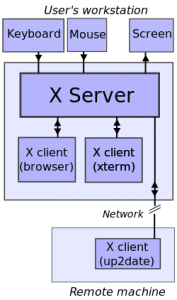Okay. Back in the days of Windows 95 and 98, I learned how to customize my setup as best as I could. This included changing desktop wallpaper, the window buttons and title bars, the Start Menu, the sounds, and the mouse cursors. I customized other things too, but let’s not get carried away here. This blog is nothing if not a paragon of cohesive discourse.
So when I started using Linux in June of 2007, I immediately went off in search of the methods, means and monkeys of customization. How does one change the way the GUI looks and acts in Linux. I discovered that, as a consequence of the open nature of Linux and the apps that make up the rest of any given distro, there are many ways of doing things. This is freedom, but this is also confusion.
How things get changed depends a lot on which desktop environment you use. For most new Linux desktop users out there, the way GNOME does things is the way things are done. But there are also KDE, Xfce, LXDE and many others to consider. I for one welcome our new ant overlords am fond of LXDE simply because it is full-featured, fast and funky. By funky, I mean that it doesn’t cause the bugs with VirtualBox that I experienced with Xfce. I just wanted that last word to start with an “f”.
So LXDE has an easy way of changing the desktop wallpaper, though it doesn’t allow to “zoom” an image to full size… it only allows to “stretch” it. No biggie. I can crop images myself. With LXDE installed over top of Ubuntu or Xubuntu, I have access to other customization applets that come with those distros. And for the most part they work. But I had recently found myself flummoxed by the inability to choose a non-animated mouse cursor.
The only options in the GUI mouse cursor selector applet are animated. This was no freakin good for my very first PC, which has specs that are laughable and pathetic today. 12 years ago, it was a kick-ass machine, but that’s another rant. Animated cursors on such a machine slow it down noticeably. So when I finally figured out how to get static cursors in my Xubuntu/LXDE setup, I saw another huge boost in speed.
Now…. that was on a 12 year old machine. I next tried – just for kicks – the same tweak on my main internet PC. That machine is about 6 years old now. And I noticed another relatively huge boost in speed. This should not have been the case, my logical mind tells me. So I tried it on my parents’ laptop. That’s a low-spec machine I bought them so they could see the wonders of the internet. On that laptop, I saw the same kind of huge boost in speed.
There’s obviously something else going on here. For me to see the same kind of speed boost on newer machines as on old machines tells me it’s not merely the change in cursor graphics that’s speeding things up.
What I’m about to say may be wrong, and I ask now that my readers (I think I can safely use plural here) correct me on some points. But here goes. The static mouse cursor that speeds things up so much is “drawn” by X-11, which is the basic software layer between the user and the hardware. This diagram shows what I’m talking about:

It’s my belief that those dumbass, cartoony looking puffy animated mouse cursors that come with Ubuntu are drawn by something layered on top of X-11. This would mean that not only does the system have to work harder in making the actual constant animations to the cursor, it has to go through two different software sets to make the ugly puffy cartoony mouse cursors appear in the first place.
So help me out here. Did I get it right or am I off on a wild tangent of stupid? Either is possible.
Whatever caused the big speed boost I saw on all machines, it reveals to me a problem with the way the mouse cursor situation is handled in Linux. If I had the smarts to program code, I’d take a closer look at it all and try to come up with a solution myself. But I don’t and I can’t, so I’ll just bitch and whine.
